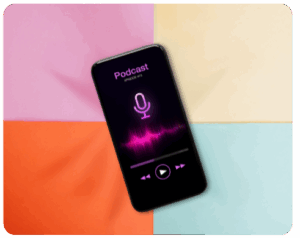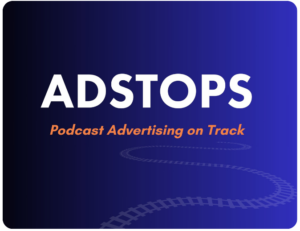
Podcast ad spending continues to grow, and the IAB notes it’s on track to hit the $2.6 billion mark by 2026. But how do brands measure podcast advertising effectiveness on performance and measure the return on investment?
This increased consumption offers exciting opportunities to connect with engaged, niche audiences through podcast advertising. However, podcasting’s growing popularity doesn’t automatically translate into podcast ad performance and successful sponsorship campaigns.
Impressions are the cornerstone of podcast advertising metrics. Impressions—which can mean downloads, streaming listens, or even YouTube views—are generally what podcast advertising is priced against but Impressions only provide a snapshot of a campaigns performance.
For a successful campaign with strong ROI, it’s essential to track and optimize performance through key metrics—both from the podcast itself and from brand-specific data. Understanding these metrics can help you make data-driven decisions and refine your approach.
Let’s explore the most important podcast advertising metrics, how to interpret the data, and why starting with a test campaign can be a game-changer for optimizing your results.
Measuring Podcast Advertising Starts With Data
The first place to look is at the data from the podcast itself. These metrics reveal how effectively your ad is reaching and engaging listeners.
- Downloads: Downloads are counted when at least one minute of an episode is downloaded. To ensure accuracy, they should be filtered to exclude invalid and bot traffic and be counted within a single day. Downloads reflect the number of times an episode with your ad was downloaded, though not necessarily listened to. In some cases, downloads may be synonymous with "impressions," similar to YouTube veiws.
- Geographical and Device Information: We can also learn more about podcast ad performance by examining geographical and device information using a tracking pixel. Pixels capture where and how listeners engage, including:
- Geographic Information: Tracking pixels can capture details down to the region, country, or city level, providing insights into listener location.
Device and Platform Data: Pixels can record device type (e.g., mobile, desktop, tablet) and operating system (such as iOS, Android, or Windows), giving a clearer view of the devices and platforms your audience uses.
- Geographic Information: Tracking pixels can capture details down to the region, country, or city level, providing insights into listener location.
- Listens (or Streams): Listen data is available for some streaming audio campaigns (e.g., Spotify Ad Studio) but not across all platforms. Listens indicate playback time, offering an idea of actual engagement.
- Impressions: Impressions track ad requests, meaning each time an ad is downloaded or "called" by a listener’s app. Impressions reveal how many times an ad was potentially available to listeners but cannot indicate if it was heard.
If a Download Happens, Does Anyone Hear?
If a listener downloads an episode and only plays part of it or skips ahead, that ad may never be heard, but it still counts as an impression.
Example 1: The Stop and Start Listen
A listener starts a 1-hour podcast episode. When she hits play, her app downloads the episode. She listens to a pre-roll ad but stops after a few minutes. Later, she resumes, and the app downloads from where she left off, with no additional pre-roll ad playing. This scenario would reflect two downloads but only one impression.
Example 2: The Partial Listen
For a two-hour podcast episode, a listener hears the first 30 minutes, downloading the first hour, including a mid-roll ad at the 45-minute mark. Since he doesn’t listen that long, he misses it. When he resumes later, the app requests a new ad. Here, data would show one download and two impressions, as the ad was requested twice.
How to Interpret Podcast Performance Data
Understanding how these metrics interact can help you evaluate an ad’s effectiveness. For example, high impressions with low promo code redemptions may signal the need for revised ad copy. Likewise, under-delivered downloads could call for make-goods or renegotiated placements.

Brand Performance Data
Once you’ve reviewed podcast-side data, it’s time to look at brand-specific metrics. These measure how well your ad drives engagement and conversions.
- Promo Code Usage: Unique promo codes directly track listener engagement, helping you capture how many listeners responded to your ad.
- UTM Links & Pixels: UTM parameters and pixels capture the digital path of listeners who clicked through to your site after hearing the ad, providing insights into traffic and conversions.
- Landing Page Metrics: Key metrics like visits, bounce rates, and conversions help gauge ad effectiveness. A high number of visits paired with a low bounce rate suggests qualified traffic.
- Customer Acquisition Cost/Cost Per Acquisition (CAC/CPA): CAC or CPA reveals how much it costs to acquire each new customer through your podcast ad. To calculate, divide your total ad spend by the number of new customers generated.
How to Interpret Brand Performance Data

Brand metrics help assess how well your ad drives actual results. For example, UTM links with high traffic but low conversions may suggest a need to update your landing page. Analyzing promo code usage with CAC can further determine the cost-effectiveness of your campaign.
- Downloads vs. Promo Code Usage: High downloads but low promo code redemptions may indicate an audience-product mismatch or the need for a more compelling call to action.
- Impressions vs. Conversions: High impressions with low conversions suggest listeners may hear the ad but aren’t motivated to take action, perhaps due to the offer, ad copy, or placement.
Bridging the Gap Between Podcast and Brand Data
Combining both podcast-side and brand metrics provides a holistic view of your campaign’s effectiveness, enabling strategic adjustments.
- Frequency vs. Brand Awareness: If high frequency isn’t driving brand awareness, it may be time to adjust your messaging or target audience.
Running a Test Campaign
Before launching a full-scale campaign, start with a test campaign to refine your strategy. Testing different podcast ad placements (pre-roll, mid-roll, post-roll), genres, and messaging styles helps gather early performance data, guiding your approach before scaling up.
- Gather Initial Performance Data: Test campaigns help evaluate impression data, promo code usage, and landing page traffic, highlighting what works best.
- Refine Messaging: Experiment with messaging to see what resonates with listeners.
- Optimize CAC and ROI: Use initial data to adjust your approach, reducing CAC and improving ROI.
Optimizing for Success
Once you have your data, here are a few ways to optimize your podcast ad performance:
- Test New Offers: If promo code usage is low, try new incentives or discounts to attract listeners.
- Adjust Ad Copy: Use insights from test campaigns to refine your podcast ad copy for better engagement.
- Choose the Right Podcasts: Focus on podcasts with high engagement and a good fit for your target audience.
- Monitor CAC and ROI: Continuously track CAC and ROI, adjusting placements, targeting, and messaging to maximize results.
Conclusion

Podcast ad performance goes beyond impressions. By tracking and optimizing performance through key metrics—both from the podcast itself and from brand-specific data. you can fine-tune your strategy for optimal results. Starting with a test campaign allows you to make data-driven adjustments, maximizing the impact of your podcast advertising efforts.
ADOPTER Media
We believe in data-driven results and are dedicated to helping everyone make better decisions and advance their work using a platform trusted by Fortune 500 companies and beloved regional brands alike. Have a question about podcast advertising or YouTube sponsorship? Connect with us and we will be happy to help!

